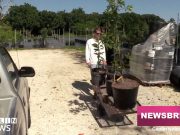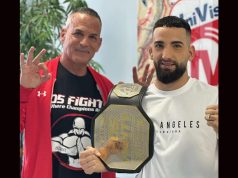In July 1990, police pulled over 23-year-old Thomas Raynard “Jay” James, then found marijuana and an illegal gun in his car. After three long weeks of sitting in jail, James finally headed to court for a hearing. It was there that prosecutors dropped the nuke. He was wanted for the murder of Francis McKinnon in a robbery gone bad in Coconut Grove six months before.
James knew nothing about that crime.
“My incipient thought was that they got my file mixed up with one of the other guys who was going to court the same day,” James says. “So I’m thinking, ‘Okay, they’re gonna get it straightened out.’”
Now 55 years old, the former small-time hustler and marijuana dealer says he never committed any serious crimes. Yet after a trial that lasted only two days in which his attorney decided against calling any defense witnesses, he was convicted of murder in the 1st degree. In January 1991, Judge Milton Hirsch sentenced him to life in prison.
To read Part 2 of this series, click here
Then this past April 27, 32 years after his conviction, with the help of his family, friends, a dogged reporter, a personal injury lawyer just two years out of law school, and his own unmatchable will, a judge declared James wrongfully convicted and finally allowed him to breathe free air again.
“It was shocking to me that every aspect of the system could just jump the rails like that and literally railroad a man into prison for life based on nothing,” says Tristram Korten, the Miami journalist whose investigative story helped free James.
James grew up in the Brownsville neighborhood of Miami-Dade County before moving to an area near NW 32nd Avenue and 87th Street. As a teenager, he aspired to be a football player. When young dreams started to fade, James hit the streets.
He was out of school by age 17, dedicating his life to hustling pot around the projects of Brownsville. Ambitious and persistent, he didn’t see himself spending the rest of his days slinging dope for a quick buck. He had dreams of being a business owner and investor. He even opened a car wash on NW 79th Street and 32nd Avenue, with the intention of opening more. That was possible because of the money he made from selling pot.
“That was like a launchpad for me,” James said. “That was my ‘Shark Tank,’ to garner funding to open up established businesses.”
However, the bill did not go unpaid. Miami in the early ‘90s was dealing with a huge surge in crime and in the midst of the crack-cocaine epidemic. The police were under pressure to get things under control.
James was no stranger to police interaction. He had been charged with cocaine and cannabis possession as well as trespassing. When police stopped him that day in July 1990, he was on probation for knocking down a cop while fleeing a raid on a housing project.
A few months before the stop, on January 17, a robbery turned murder occurred in apartment 110 of a complex at 135 So. Dixie Hwy, about seven miles from Brownsville. According to police and media reports, Ethra McKinnon, her daughter Dorothy Walton, and Dorothy’s husband Johnny were in the living room of the small apartment when two men burst in. Francis McKinnon, Ethra’s husband, was resting in the bedroom. One of the men wore a mask while the other went bare-faced. With weapons drawn, the pair demanded the family get down on the ground while they rummaged through purses and drawers looking for money.
Amid the robbery, Francis McKinnon emerged with a snub-nosed .38 caliber revolver to defend his family. One of the gunmen shot and killed him. The intruders quickly gathered what they could and ran away into the night.
Police soon arrived in the area and began interviewing witnesses. They found one, Regina Ortiz, who said she had seen the two men running toward the highway after the murder. She said she recognized one of them as Vincent Cephus Williams a.k.a. “Dog,” a known criminal in the neighborhood. He had often been involved in robberies of gamblers and drug dealers, understanding they were unlikely to call the police for help.
As police interviewed more witnesses, tips started coming in mentioning the name Thomas “Tommy” James, who was known to run with Dog. Police soon came up with two suspects of that name. In July 1990, just six months after the murder, police pulled over Thomas Raynard James and arrested him after they discovered a Tech-9 in the trunk of his car.
He expected jail time and understood what it meant, having been arrested for a few minor crimes such as trespassing and marijuana possessions before that day prosecutors described the charges in the courtroom.
“Reality set in when they took me downstairs and fingerprinted me,” James said. “I was no longer struggling and fighting for financial freedom. It was just for my freedom.”
James had figured that at some point along this process, someone would realize this was a mistake. He knew he never killed or robbed anyone. He couldn’t remember the last time he had been near Coconut Grove, where the murder took place.
However, when detectives showed Dorothy Walton a lineup of potential suspects, she identified James as the man who had entered the house without a mask that day and killed Francis McKinnon. Dorothy’s mother, Ethra, even told police she knew Thomas James’ mother. James was also identified by another eyewitness, Larry Miller, who had a cognitive disability that hindered his speech. He said James was one of two men who had approached him for a cigarette shortly before the murder.
James’ public defender, Owen Chin, met with him only three times before the trial. Each time, Chin gave the impression that James was guilty.
“For some reason, he was convinced that I had committed the crime,” James said of Chin.
At the trial, the prosecution called Ethra McKinnon, Dorothy Walton, and Larry Miller. Neither Miller nor McKinnon identified James as the killer at the trial, but Walton doubled down.
That was the most damning evidence against James. The rest of the witnesses were police officers, investigators, detectives, and medical examiners who provided no direct evidence about James’ role in the crime.
Chin chose not to call any witnesses in his client’s defense and simply cross-examined those the prosecution presented. In January 1991, the jury found James guilty and later sentenced him to life in prison.
“They really didn’t have any evidence,” James said. “They had nine sets of fingerprints… but none of them matched me.”
About a year into his sentence, a glimmer of hope lit up the pitch-black darkness. An inmate at Hendry Correctional Institution came to James and alleged that a man who shared his first and last – but not middle – name had committed the crime.
Thomas Raynard James became hellbent on uncovering the truth. He believed the truth would set him free.
“I knew I was innocent and I wasn’t gonna let anything stop me short of death from trying to prove it,” James said. “There [was] a certain amount of anger that resides in me. But it is an anger that motivates me to want more, to want better for myself, to prove all that I said, that I am innocent,” He continued.
Five years after his conviction, four after the tip that another Thomas James was the killer, inmate James finally received the files from his case. He reviewed them and discovered there were more than four people present in the apartment that night. That hadn’t been mentioned at trial.
Three children, none related to each other or anyone else in the South Dixie Highway home, were also there the night of the murder. And the file showed that Ethra McKinnon had mentioned that Thomas James’ mother was named Mary, but his mother was named Doris.
Then he asked a prison staffer to check if another Thomas James came up in the state database. The staffer soon found another man of that name, six years younger, who had been convicted as a habitual offender in 1996 and sentenced to life. The other Thomas James had a mother named Mary and lived just a few miles away from where the murder had taken place.
James spent the next nine years searching for evidence of his innocence. In 2005, he learned from one inmate, Andre Slaton, that the man named Dog had bragged about hitting a numbers house when he was confronted by one of the residents who was then killed. James asked Slaton to share that information in a signed statement.
He repeatedly requested a new trial, but all those petitions were denied. He would file them himself as he and his family did not have the resources to hire a lawyer to help. But James refused to give up. As time went on and his family passed word of the alleged misidentification on social media, his reach would be bigger than ever.
“My family and friends have been with me throughout the duration of my entire incarceration. I was never by myself in my fight,” James said.
James’ family passed out flyers and knocked on doors looking for any information that may help him in his quest for freedom. They made T-shirts and posters to help spread the word.
In 2014, a friend of the family shared a Facebook post with a picture of Thomas Raynard James asking for any tips that may help.
A woman named Josmine Byrd saw the post. As an 8-year-old, she was one of the three unmentioned children in the McKinnon’s apartment the night of the crime.
She got back to the family and offered to testify about what she witnessed that January 17. She added that she had never been formally interviewed by police about that night.
In a signed notarized statement, Byrd claimed she had a clear view of the shooter that night and that James was not the man who did it. James used the statement to file another appeal, but like the others, it was swiftly denied.
After yet another failed appeal following Josmine Byrd’s signed notarized statement, it seemed that James was destined to rot away in jail.
Until suddenly, destiny called his number.
To read Part 2 of this series, click here


































